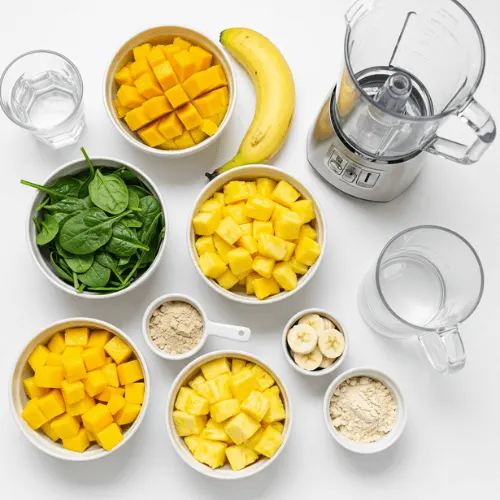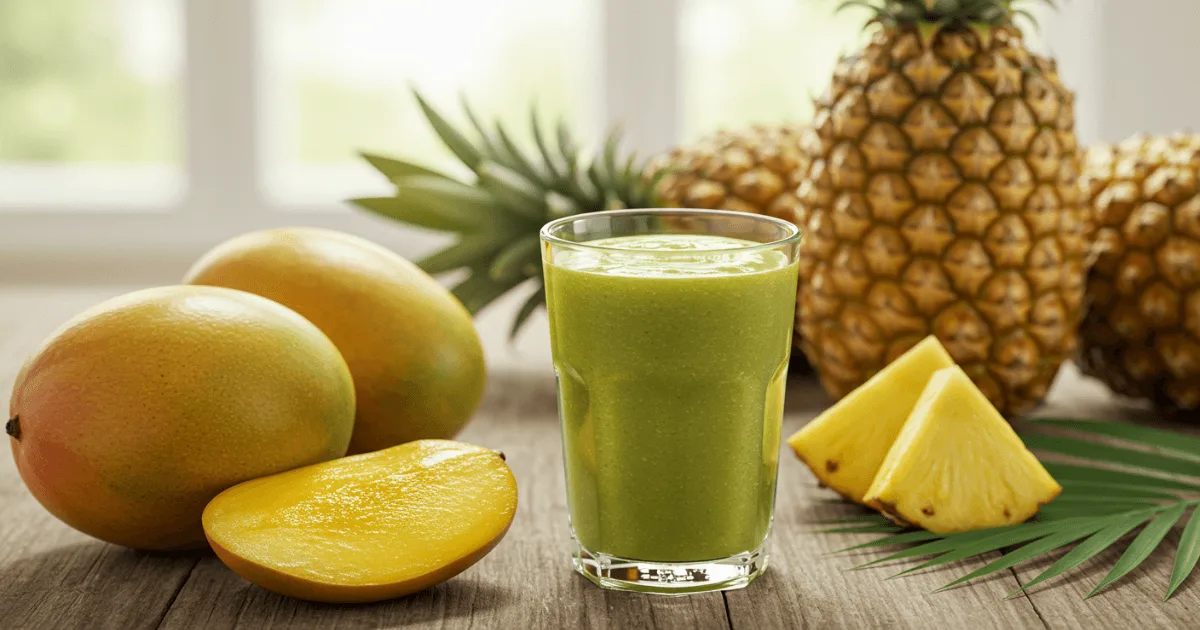Close your eyes and take that first sip—suddenly you’re barefoot on warm sand, the tang of fresh pineapple dancing with creamy coconut on your tongue. This isn’t just a drink; it’s your daily 3 pm escape in a cup, packed with all the Tropical Smoothie calories your taste buds crave (and none of the guilt).
Here’s the beautiful truth: Those Tropical Smoothie calories you’re sipping? They can align with your health goals. We’re not here to drown your vibe in boring numbers (though we’ll give you the calorie breakdown you need). Instead, let’s find that perfect sweet spot where indulgence meets nourishment—where your favorite Tropical Smoothie becomes the hero of your day, not a nutrition nightmare.
Table of Contents
Whether you’re:
- A gym rat needing a high-protein smoothie fuel
- A busy mom craving low-calorie tropical drinks that satisfy
- Or just someone who believes joy should come with a straw
We’ll help you navigate Tropical Smoothie Café’s menu like a pro. Why settle for dull smoothies or food regrets when life is so brief?
Ready to rediscover your favorite Tropical Smoothie flavors in a whole new light? Let’s blend up some happiness—one smart sip at a time.
The Real Scoop: What Are Tropical Smoothie Calories?
When you think of a tropical smoothie, you likely picture a vibrant mix of fresh mango, pineapple, banana, and perhaps some creamy yogurt or protein powder. But here’s the catch: those sweet, tropical flavors come with a calorie range that can surprise you.
What Makes Up Those Calories?
- Fruit: Mangoes, pineapples, and bananas naturally contain sugars that contribute calories.
- Using juice: coconut water, or dairy/non-dairy milk as the liquid base will impact the calorie count in different ways.
- Add-ins: Protein powders, nut butters, and yogurt add richness and calories.
- Portion size: 16 oz, 24 oz, or even 32 oz servings significantly change total calories.
To give you a clearer picture, here’s a quick look at some popular tropical smoothies from Tropical Smoothie Café, whose nutrition information is widely referenced:
| Smoothie Name | Calories | Sugar (g) | Protein (g) | Fat (g) |
|---|---|---|---|---|
| Bahama Mama | 510 | 99 | 3 | 2 |
| Island Green Detox | 180 | 29 | 4 | 1 |
| Peanut Paradise | 710 | 66 | 27 | 20 |
(Source: Tropical Smoothie Café Nutrition Chart)
Notice how the Bahama Mama clocks in at over 500 calories, while the Island Green Detox is under 200. This wide range shows how ingredient choices make all the difference.
What Affects Calorie Count in Tropical Smoothies?
If you want to truly control your calorie intake without giving up your tropical fix, understanding the calorie influencers is key.
Ingredients That Add Up
- Fruits: While mango-pineapple combos are delicious, they are naturally high in sugar. For example, the Mango Pineapple McDonald’s Smoothie is a popular tropical-inspired drink, but it tends to pack a higher sugar and calorie punch compared to homemade versions.
- Sweeteners & Juices: Many tropical smoothies include orange juice or added sugars to boost flavor, which spike calories quickly.
- Protein Powders: You might find options like vegan diet protein powder or a shaved ice smoothie, which adds protein without excessive calories, but watch out for some powders with hidden sugars or fats.
- Nut Butters & Yogurts: These add creaminess and nutrients, but also calories.
Portion Size Matters
A 16 oz tropical smoothie is not the same as a 32 oz one. Many chains upsell larger sizes, meaning you consume double or triple the calories without realizing it.
Blender Mistakes That Sneak In Calories
- Not measuring ingredients carefully.
- Adding too many “healthy” extras like seeds, coconut flakes, or granola can quickly raise calorie totals.
Healthiest Tropical Smoothies for Your Goals
We get it—you want that tropical vacation in a cup and to feel good about what you’re drinking. The good news? You don’t have to choose. Here’s your personalized guide to sipping smarter, with options that match your goals (no rabbit food required).
1. For the Clean-Eating Crowd: Low-Calorie, High-Nutrition Heroes
“I want something light but still satisfying!”
Star Player: Island Green Detox
- Why it wins: At just 180 calories for a 24-oz, it’s like a salad in sippable form—but delicious.
- What’s inside: Spinach, kale, mango, pineapple, and ginger (hello, digestion boost!).
- Pro tip: Make it even cleaner by:
- Using coconut water as the base instead of juice saves more than 50 calories.
- Skipping the “light agave” (those sneaky extra 40 calories add up)
Bonus Hack: Ask for extra ginger—it gives a metabolism-friendly kick that makes this smoothie anything but boring.
2. For the Protein Seekers: Post-Workout Powerhouses
“I need something that’ll keep me full and help my muscles recover.” Build Your Champion:
- Base: Almond milk (80 cal) or coconut water (45 cal)
- Body: 1 scoop plant-based protein (+100–150 cal)
- Boosters:
- One tbsp of chia seeds (provides 60 calories, omegas, and dietary fiber)
- ½ banana (+50 cal; natural electrolytes)
Why This Works: At ~300 calories, it’s a meal replacement that keeps hunger at bay for hours, unlike those bland “protein shakes” that taste chalky.
3. For the Sweet Tooth with Boundaries
“I want dessert… but make it ~healthy~.”
Surprise Winner: Acai Berry Boost
- Secret Sauce: The acai base is naturally lower in sugar than other tropical fruit blends.
- Smart Swaps:
- Substitute Greek yogurt for sherbet (+15g protein, -10g sugar)
- Choose fresh berries over granola as a topping to save more than 150 calories.
Fun Fact: This modified version tastes like a berry parfait but packs the same antioxidants as a superfood bowl!
The Golden Rule of Smoothie Success
Your blender or barista is your co-pilot. Almost any menu item can be tweaked—don’t be shy about:
- “Can you make it with half the banana?” (saves 50 cal)
- “Extra spinach, please!” (adds nutrients for ~7 calories)
- “Hold the honey drizzle.” (Your waistline will thank you)
At the end of the day, the best smoothie is the one that makes both your taste buds and your body happy. Now go forth and sip joyfully!
DIY Recipes: Make Your Own Tropical Smoothie
Want to control exactly what goes in your smoothie? Here’s an easy recipe that keeps calories in check but delivers big on flavor.
Tropical Mango-Pineapple Smoothie (Under 200 Calories)
| Ingredient | Quantity | Calories |
|---|---|---|
| Frozen Mango | ½ cup | 50 |
| Frozen Pineapple | ½ cup | 40 |
| Coconut Water | 1 cup | 45 |
| Spinach (optional) | ½ cup | 5 |
| Ice Cubes | handful | 0 |
Instructions:
- Combine all ingredients in your blender.
- Blend until smooth.
- Enjoy immediately for a fresh, light tropical treat.
Pro tip: Add a scoop of vegan diet protein powder to boost protein while keeping calories moderate (~250 total calories).
Understanding Smoothie Bowls & Calories
You might have noticed smoothie bowls becoming a trendy breakfast or snack option. But how do their calories stack up?
What’s Inside a Smoothie Bowl?
- Thick, creamy smoothie base made from fruits and sometimes yogurt or nut butters.
- Toppings like granola, seeds, shredded coconut, or fresh fruit.
Here’s a calorie overview for common smoothie bowls:
| Smoothie Bowl Type | Avg Calories | Notes |
|---|---|---|
| Acai Bowl | 400–600 | Typically lighter with a vegetable base |
| Green Bowl | 300–450 | Typically lighter with a vegetable base |
Be mindful: Overloading on toppings can push calorie counts sky-high without you realizing it.
Calories and Weight Goals: What to Know
Balancing tropical smoothie enjoyment with your weight goals requires smart choices.
To Lose Weight: Stay in a Caloric Deficit
- Aim for smoothies under 300 calories.
- Pair smoothies with whole food meals to keep you full.
- Remember, daily calorie needs for weight loss vary but usually fall between 1,200–1,800 calories for many adults.
To Gain a Healthy Weight: Use High-Calorie Smoothies
- Incorporate calorie-dense ingredients like oats, nut butters, avocado, and full-fat dairy or coconut milk.
- The Peanut Paradise from Tropical Smoothie Café is a good example of a higher-calorie, protein-rich option (over 700 calories).


FAQ: Tropical Smoothie Calories & Dieting
How many calories are in a tropical smoothie?
Depending on the ingredients, tropical smoothies can be as light as 180 calories or as rich as over 700 calories:
- Size (small vs. large)
- Ingredients (fruit, yogurt, nut butters, sweeteners)
- Add-ins (protein boosts, syrups, or supplements)
For example, a basic fruit blend may stay under 200 calories, while a large smoothie with peanut butter, protein, and coconut milk can easily exceed 600 calories.
What’s the healthiest smoothie at Tropical Smoothie Café?
The Island Green Detox is a top pick for health-conscious sippers, packing only 180 calories (for a 24-oz serving), with spinach, kale, mango, pineapple, and ginger for a vitamin-rich blend and no added sugars (if ordered as-is).
Other lighter options include Lean Machine (230 cal.) and Detox Island Green (with ginger and flaxseed for extra benefits).
Are smoothies high in calories?
They can be—especially if they include sweetened fruit juices or syrups, nut butters, chocolate, or sweetened yogurt, and large portion sizes (some café smoothies are 32 oz. or more).
Tip: Opt for “light” versions, skip added sugars, and choose smaller sizes to keep calories in check.
Smoothie Bowls: Calories & Diet-Friendly Choices
Smoothie bowls often range from 350–700+ calories, with toppings making a big difference:
- Higher-calorie toppings: Granola, coconut flakes, honey, chia seeds
- Lighter options: Fresh berries, unsweetened coconut, a sprinkle of nuts
Are they good for weight loss? Yes—if you:
- Use a low-sugar base (like unsweetened acai or Greek yogurt)
- Watch portion sizes (stick to 1–2 modest toppings)
How many calories should you eat per day?
Most adults need 1,800–2,400 calories/day, but this varies by:
- Age and gender (men often need a higher amount; metabolism reduces with aging)
- Activity level (active individuals require more fuel)
- Weight goals (weight loss usually requires a calorie deficit)
Are smoothies good for dieting?
Yes—if you choose wisely! Benefits include:
- Portion control (pre-measured ingredients)
- Nutrient density (packed with vitamins, fiber, and protein)
- Appetite satisfaction (protein & fiber keep you full)
Watch out for:
- Hidden sugars (in syrups, sweetened yogurts, or juices)
- Oversized servings (a 32-oz. smoothie can be a meal and dessert in one)
How to Make a 1,000-Calorie Smoothie (for Weight Gain or Fueling)
Need a high-calorie boost? Blend:
- 1 banana (100 cal)
- 2 tbsp peanut butter (190 cal)
- ½ avocado (120 cal)
- 1 cup oats (300 cal)
- One cup of whole milk or coconut milk, containing over 200 calories
- 1 scoop protein powder (100–150 cal)
How many calories need to be reduced to achieve weight loss?
Usually, sustaining a daily deficit of 500–750 calories can cause a weekly weight reduction of 1–1.5 pounds.
Smoothies can help as meal replacements—just track ingredients!
If you typically burn 2,000 calories each day, maintaining an intake of 1,500 to 1,700 calories could support gradual weight reduction.
Final Thoughts: Enjoy Your Smoothie, Love Every Sip—Mindfully
Now you’re equipped to enjoy tropical smoothies with confidence. Whether you’re grabbing a Mango Pineapple McDonald’s Smoothie or crafting your tropical creation at home, understanding the calories empowers you to savor every sip without guilt. So go ahead—love your tropical smoothie like 8 days a week, but make sure it loves your body back.
Call to Action
Ready to take control of your smoothie choices? Try crafting your tropical smoothie at home using the recipes and tips above. Share your preferred combinations or any inquiries you might have in the comments! And if you’re looking for more healthy smoothie inspiration—including Hailey Bieber’s viral smoothie recipe—stay tuned for more delicious, nutritious ideas.

